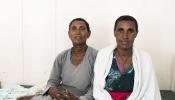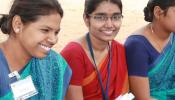This article by Heather Wardle, Development Director, Seva Canada was originally published in Opt!k Magazine, May 2011
Published here as Week 40 of Seva's "Random Acts of Seva" campaign in the lead up to Seva Canada's 30th Anniversary
Cambodia may be the only country in history where people were killed for wearing glasses.
From 1975 to 1979, the Khmer Rouge under Pol Pot systematically devastated the country, including the health care system, executing selected groups who had the potential to undermine their new state, including educated people and even those that had stereotypical signs of learning, such as wearing glasses.
Pol Pot declared the year zero and began to “purify” society. All businesses were closed, education stopped, health care disappeared, hospitals were emptied and destroyed and every city in Cambodia was forcibly evacuated. Various studies have estimated the death toll at between 1.4 million and 2.2 million.
The genocide inflicted deep wounds on Cambodia and its people that will endure for generations to come. In eye care, as in every other aspect of society, the effects are still being felt 32 years later.
Earlier this year, I was part of a group of Seva Canada donors who travelled to Cambodia on a self-funded trip to observe Seva’s eye care programs in that country.
The day after our arrival in Siem Reap, we stepped out of our hotel and saw a small boy leading his blind father through the streets, begging from the tourists. They were hungry, so we invited them to join our group for lunch and learned their story. The father had been blinded by a landmine explosion. His 6-year-old son was his full-time caregiver and would likely never go to school.
Blindness is an enormous problem in Cambodia. There are about 168,000 Cambodians who are blind and, as is true in nearly all developing countries, 80% of this blindness is due to preventable or treatable conditions such as cataract. The backlog of cataract blind is estimated to be 90,000 people and there are a further 20,000 who go blind from cataract each and every year.
The Seva programs we witnessed involved reaching out to those who need care through screening programs in schools, orphanages and remote rural communities; provision of direct services such as glasses and eye surgeries (cataract, strabismus, pterygium, etc.); childhood blindness programs; and training of eye care professionals, health workers and volunteers.
The highlight of our trip was seeing all the stages of Seva’s annual 4-week long eye camp that takes place across the three western provinces of Siem Reap, Banteay Meanchey and Battambang. It was the dry season, just after the rice harvest, and a perfect time for people to travel and for the teams to go out in the countryside and find those with vision problems.
“As we arrived at the rural screening camps, the waiting rooms were full of patients who had come to be seen by the eye care staff. Walking through the crowd, I could feel their anxiety and their hope,” said Jo-Ann Labron, a Seva donor.
As a group, we were deeply inspired by the work being done in Cambodia. “As I atched patients move through the process of screening, referrals, and in many cases eye surgeries, I saw a remarkable transformation of spirit. Once liberated from their world of blindness, the patients overwhelmed me with their gratitude. For me, it was a gift to be able to see the full impact of Seva’s work,” said Ms. Labron.
“Cambodia lost so much during the war and conflict in recent years,” explains Dr. Chundak Tenzing, Director of Seva’s Sight Program. “They have to rebuild their health care system infrastructure from the ground up. But there’s already been real progress and the situation keeps improving.” An example of this change is the Battambang Ophthalmic Care Centre which we visited. This bustling non-profit clinic in the dusty centre of Battambang town performs thousands of eye surgeries a year and keeps expanding its outreach work and services.
A key part of Seva’s work is building local capacity. After the genocide, there was one ophthalmologist – a foreign doctor – left in the entire country. Now, in this country of 14 million, there are nine fully qualified Cambodian ophthalmologists, four of whom were trained by Seva, as well as two foreign surgeons. One of the expatriate ophthalmologists is Seva’s Dr. Bal Kumar KC, a Nepalese ophthalmologist who has dedicated over 15 years of his life to this once war-ravaged country.
Dr. Gary Barth, a US ophthalmologist from California joined our group and was watching Dr. KC interact with patients. “The abiding impression I had was kindness,” said Dr. Barth. “Being friendly and skillful isn’t always a trait I see. Dr. KC really likes his patients. We knew he was a consummate eye surgeon, but he has these other qualities. He is the kind of guy you’d send your family and relatives to. I think the confidence that comes from being an excellent, world-class eye surgeon allows him to transcend some of the things that would frustrate others.”
One of the last patients who we saw at the eye camp in Siem Reap was a young mother with her baby. The woman was blind in both eyes and had been led to the eye camp by her friend. Tragically, this young woman had had an untreated eye infection four years earlier. The damage to her eyes was permanent. She will never see her child. Had an eye clinic and trained staff been available, with just $2.50 she could have purchased or been given a bottle of antibiotic eye drops that would have saved her sight and changed the course of her life and the life of her family.
A little goes a long way in Cambodia. A $5 pair of glasses, a $20 pterygium surgery, a $50 cataract surgery – each has a ripple effect that can be felt for generations. Each helps rebuild eye care for the people of Cambodia.
See other blog posts on Seva's work in Cambodia at http://blog.seva.ca/category/cambodia/
See other posts on Seva's Random Acts of Seva


